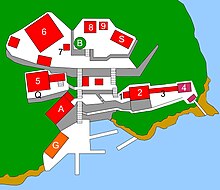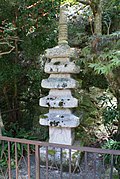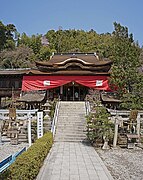Hogon-ji

The Hōgon-ji ( Japanese 宝 厳 寺 ) with the mountain name Gankon-san ( 巌 金山 ) is located on the island of Chikubu in Lake Biwa , which belongs to the city of Nagahama ( Shiga prefecture ). It is a temple of the Busan branch ( 豊 山 派 Busan-ha ) of the Shingon branch of Buddhism. As an exception, the main cult figure is not a Kannon , but the female figure among the seven gods of luck , the Benzaiten , who prefers an island as her domicile. This one belongs to the "Three Benzaites of Japan" ( 日本 三 弁 財 天 ;). The temple is the 30th temple on the Saigoku Pilgrimage Route in the traditional count .
history
As is recorded in the Chikubushima Enki ( 竹 生 島 縁 起 ) from the year 931, the temple was built in 738 by the priest Gyōki at the request of the Emperor Shōmu , Gyōki carved a two-foot high group of the Shitennō and built a small pavilion for them. At the time of its founding, the temple belonged to the Tōdai-ji in Nara , from the Tenryaku era (947–957) it came to the Enryaku-ji . Since the beginning of the 16th century, the temple complex Chikubushima was called Daijingū-ji.
The temple complex
From the pier there is a steep staircase of about 20 steps up to a torii . The abbot and monk's quarters are also on the left (A on the map). After another 30 steps you come to the large stone torii with the inscription 厳 金山 Kankonzan . The path to the right leads to a building complex consisting of the " Kannon Hall" ( 観 音 堂 Kannon-dō ; important cultural asset of Japan , marked with ◎ in the following; 2), which can be seen through a “Chinese” designed entrance area Karamon ( 唐門 ; 1), which is registered as a national treasure, enters. Behind it, a "boat corridor" ( 舟 廊下 Funa rōka ; ◎; 3) placed on a beam structure leads to an earlier pier, which was built with material from a residence of Toyotomi Hideyoshi . Karamon and Kannonhalle are covered with cedar shingles ( 檜 皮 葺 Hiwada-buki ).
Back to the stairs: on the left is the gettei-in ( 月 定 院 ; 5), in front of it the “source of pure water” ( 瑞祥 水 Zuisho-mizu ; Q). Up it goes on, 167 stone steps up to the main hall ( 本 堂 Hondō ; 6) of the temple, here called "Benten Hall" ( 弁 天堂 Benten-dō ). The current building was built in 1942 in the style of the Heian period . It is 5 ken wide and 4 ken deep and has a hipped foot roof that is covered with cedar shingles. In front of the main hall there is a 2.46 meter high five-story stone pagoda ( 五 重 の 石塔 Gojū-no-sekitō ; 7) from the Kamakura period . The Benten as the main cult figure is shown here sitting on a lotus blossom.
A short staircase leads to a higher temple area. There is behind the “Mochi tree” ( 黐 の 木 Mochi no ki , Ilex integra ; B) a three-story pagoda ( 三重 塔 Sanjū-no-tō ; 8) and next to it the “Uhō Pavilion” ( 雨 宝 堂 Uhō-dō ; 9). The Hōmotsu-den treasury is also located here ( 宝物 殿 ; S).
At the bottom of the pier there is a restaurant (G).
The Chikubushima Shrine
The Chikubushima Shrine ( 竹 生 島 神社 Chikubushima jinja ; 4), also called Tsukubusuma Shrine ( 都 久 夫 須 麻 神社 Tsukubusuma-jinja ), joins the boat passage in the east and has been connected to the temple since ancient times. Various island gods are worshiped in the shrine. The main hall ( 本 殿 Honden ; 4) is registered as a national treasure. It is 3 × 3 Ken in size, has a hipped foot roof that is covered with cedar shingles and has a ridge in the Chinese style on the front and back. The hall, which was lost in a fire in 1558, was rebuilt in 1567. In 1602 a building was moved here from outside for a visit by Toyotomi Hideyori . Exactly where from is not clear, in any case it is designed in the style of the Momoyama period . The sliding doors and ceilings are said to have been painted by Kanō Mitsunobu .
Temple treasures
In addition to the Karamon, the introduction to the Hokke Sutra ( 法 華 経 序 品 Hokke-kyō johon , also called Chikubushima Sutra ( 竹 生 島 経 )) is registered as a national treasure. It dates from the 11th century.
The temple also has the following important cultural assets (üter):
- Pictorial representations, colored on silk: 16 Arhat ( 絹本 着色 十六 羅漢 図 Kenpon chakushoku jūroku rakkan-zu ), Shaka trinity ( 絹本 着色 釈 迦 三 尊像 Kenpon chakushoku Shaka sanzon-zō ), a six-armed, seated Kannon ( 絹本 着色 如意輪 観 音像 Kenpon chakushoku nyoirin Kannon-zō ), Amida ( 絹本 着色 阿 弥陀 来 迎 図 Kenpon chakushoku Amida nyorai-zu ), North Star ( 絹本 着色 北斗 九星 像Kenpon chakushoku hokutokyūsei-zō ),
- Embroidery: figures of saints ( 刺 繍 普賢 十 羅刹 女 図 額 Shishu jūrasetsunyo-zugaku ) and Amida trinity ( 刺 繍 阿 弥陀 三尊 来 迎 図 額 Shishu Amida sanzon nyorai sugaku ),
- Objects: Great sword ( 毛 抜 形 太 刀 Kenukigata tachi ), bronze water vessel, signed 1288 ( 銅 水瓶 弘 安 十 一年 銘 Dōsuibin Kōan 11-nen ), a seal ( 印 In ) from the Kamakura period,
- the script Chikubushima bunsho ( 竹 生 島 文書 ).
photos
Remarks
- ↑ The other two are Enoshima Shrine in Kanagawa Prefecture and Itsukushima Shrine ( Hiroshima Prefecture ).
literature
- Shiga-ken rekishi sampo henshu iinkai (ed.): Hogon-ji . In: Shiga-ken no rekishi sampo (ge). Yamakawa Shuppan, 2008. ISBN 978-4-634-24825-0 . Pp. 165-168.
Web links
- Temple website (Japanese)
Coordinates: 35 ° 25 '16 " N , 136 ° 8' 35.6" E









